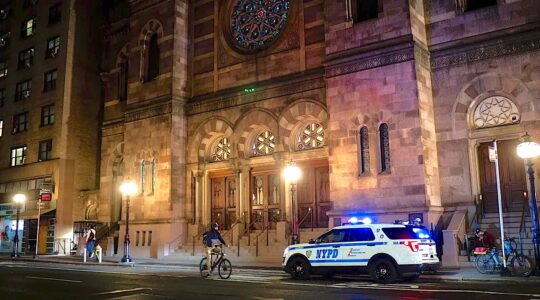Can a building do justice to the horror of the Holocaust? In Oren Safdie’s new play, “False Solution,” an egotistical German-Jewish architect (Sean Haberle) engages in a battle of wits with a sexy blonde intern (Christy McIntosh) over his plans for a new Holocaust memorial in Poland. As the two struggle to find common ground in their visions for the building, each is forced to come to grips with his or her connection to the Shoah. The play begins previews this week in the East Village.
Directed by the playwright, “False Solution” is the third play that Safdie, who is the son of famed Israeli-Canadian architect Moshe Safdie, has written about his father’s profession. In “Private Jokes, Public Places,” a Korean-American architecture student is excoriated by the all-male jury that judges her design for a municipal swimming pool. And in “The Bilbao Effect,” an architect’s plans for a massive Staten Island redevelopment project are tied to a woman’s suicide. Safdie’s plays, from “Fiddler Sub-Terrain,” about a Jewish family in Quebec, to “The Last Word,” about a Viennese-Jewish Holocaust survivor, also tend to focus on Jewish themes.
In an interview, Safdie told The Jewish Week that “False Solution,” unlike his previous forays into the ethics and politics of the architecture profession, focuses squarely on the architect’s creative process. The architect in the play, he noted, has reached the pinnacle of his profession, and is struggling not to repeat himself. “He falls back on his tricks,” Safdie explained, “and on the constant praise that he receives. The young student is the first who has the guts to challenge him. She also reminds him of when he was young, and was excited about creating something new.”
Safdie based the main character on a combination of Frank Gehry and Daniel Libeskind; the competing designs for the museum in the play derive from Libeskind’s Berlin Jewish Museum, in which even the floors and walls are tilted and ruptured, and Safdie’s father’s design for Yad Vashem, which is built into the side of a mountain. “Those two designs express the same thing in totally different ways,” Safdie said, explaining that while Libeskind tries to overwhelm the visitor with the sickening details of the Shoah, his father creates a kind of abstract, “non-building” created from an underground cavern. But, as the architect ultimately concludes in the play, “no one holds a monopoly on how to mourn.”
Safdie’s overriding objective in writing plays about architecture, he disclosed, is to “get to the human story behind buildings,” and to introduce the public to different elements of the architectural profession. “My ultimate compliment is that people walk down the street and see buildings differently.”
“False Solution” runs through June 30 at LaMaMA E.T.C., 74A E. Fourth St. Performances are Thursdays through Saturdays at 7:30 p.m., and Sundays at 2:30. For tickets, $18 ($13 students/seniors), call the box office at (212) 475-7710 or visit www.lamama.org.
The New York Jewish Week brings you the stories behind the headlines, keeping you connected to Jewish life in New York. Help sustain the reporting you trust by donating today.




